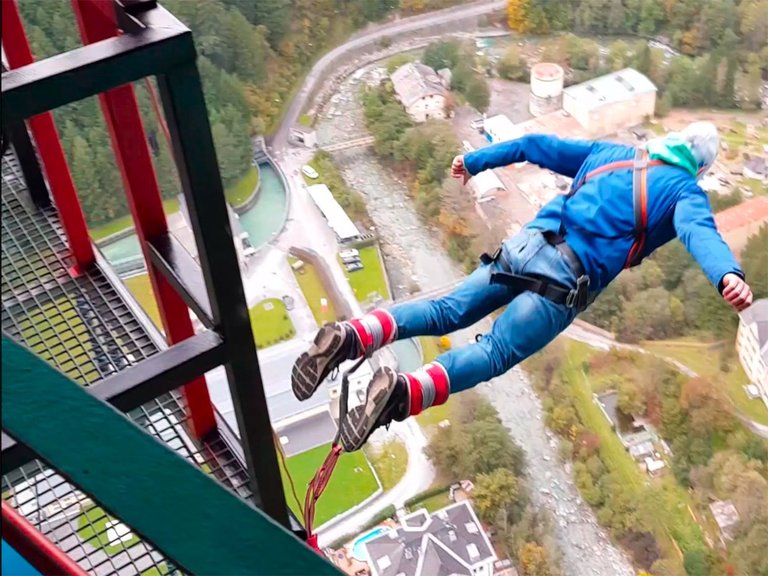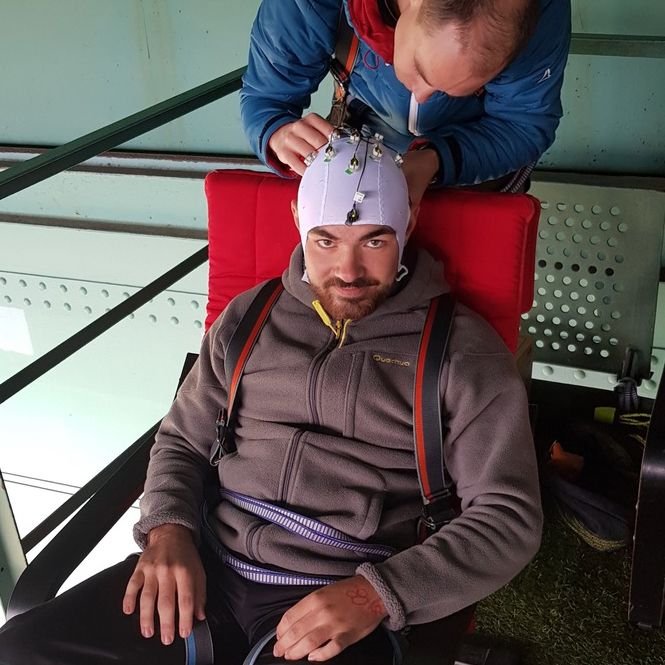The brain activity required to bungee jump may yield clues to improve brain-computer interfaces

The 19-year-old stood on the lip of Austria’s Europa Bridge, 192 meters in the air, with a bungee cord strapped to his ankles, and, after overcoming his fear, dived head first off the platform.
It was the ultimate act of free will. The bungee jumper had to internally command himself to “jump” despite his body’s strong instinct to back away from the ledge. Yet before that moment—as much as one whole second prior to becoming aware of his intention to jump—his brain had already given the command.
That command comes in the form of a distinct rising of electrical potential in the brain’s supplementary motor area. And understanding more about how it is associated with the mind’s intentions may help engineers improve mind-controlled devices.
To that end, researchers in Germany and Austria this week described a set of experiments in which they measured the brain activity associated with bungee jumpers’ free will.
The researchers, led by neuroscientist Surjo Soekadar at the University Hospital of Tübingen, say they hope the measurements will help them build better hand exoskeletons and other robotic devices that can be controlled solely by the user’s thoughts.
Such mind-controlled devices, also known as brain-computer interface (BCI) technologies, translate the brain’s electrical activity into actions. This typically involves recording the user’s brain activity with electroencephalography (EEG) and analyzing the patterns using algorithms. A computer then translates the brain activity into control signals, such as a command to move a robotic hand exoskeleton.
The challenge is to train the algorithms to correctly interpret the user’s intentions, and without a delay. So far, BCI systems have fallen short of that lofty goal. Such systems are often based on translating brain activity that is modulated during sensorimotor activities, such as when the user consciously imagines or executes a movement, says Soekadar.
But there’s a pattern of brain activity that happens before that. It’s known as the Bereitschaftspotential, or readiness potential, and it occurs in the brain’s motor cortex about one second before we’re consciously aware of our decision to move, and about 1.5 seconds before we physically initiate the movement.
Soekadar says he believes that measuring and understanding this early burst of electrical activity, combined with sensory-motor brain activity, could help him train algorithms to interpret the mind’s intentions more reliably and at the earliest possible moment. “It gives us another source of evidence that someone really wants to do something,” such as grasp an object, he says.
But all of these experiments had been conducted under strict laboratory conditions. Soekadar and his doctoral student Marius Nann wanted to know if brain waves associated with readiness potential would look the same in real-life scenarios where the participants were clearly exercising free will.
“In the lab, there’s not a lot of willpower needed,” Soekadar says. “But on a bungee jumping platform, you have to overcome your fear. It’s quite a choice because it’s a potentially life threatening situation.” Think: The rope that’s too long. The harness that breaks. 
So he recruited a couple of 19-year-olds to have their brain activity recorded as they stood on the platform of the Europa Bridge to do a series of bungee jumps. The divers chose when to jump (without a countdown from someone else) and chose how many jumps to perform (they ended up doing 30 in all).
For each jump, Soekadar equipped them with a pre-amplified, wireless EEG cap. The state-of-the art equipment allowed him to record readiness potential without artifacts, or noise, from elsewhere in the brain. A sensitive accelerometer in the helmet recorded the initiation of the dive.
The participants were chosen because they had extensive cliff diving experience. This enabled them to keep their bodies very still while on the platform, and to lead the dive with their heads, where the accelerometer was located. “They had perfect body control,” says Soekadar. Yet, “they were really nervous,” he says. Unlike cliff diving, bungee jumping required the divers to depend on the operators of the platform, who were strangers, and trust that they had assembled all the equipment correctly.
Lüder Deecke, the co-discoverer of readiness potential, joined them on the platform. The bungee experiments are “important to further develop BCI devices,” says Deecke, who spoke with IEEE Spectrum from his home in Vienna. “Previous experiments in the lab are very remote from daily living. Exoskeletons need to operate in reality.”
The experiment can also “tell us something about whether we have free will or not,” Deecke says. And that’s where Bereitschaftspotential gets heavy.
Some scientists have historically argued that since the brain activity associated with readiness potential occurs before we’re consciously aware of our intention, that serves as evidence that we don’t have free will.
Soekadar’s experiment suggests otherwise, Deecke says. In deciding to jump, a person has to “actively work against his survival instincts,” he says. “Nobody can tell me that we don’t need free will to do this.”
So the next time you find yourself in a bungee jumping harness—or perhaps simply standing at the edge of a cold swimming pool—trying to work up the nerve to take the plunge, note the distinct moment you tell yourself to jump. And know that approximately one second before that moment, your brain had already given the command.
BCI devices should respond sooner to our intentions, but perhaps not that soon.
Editor’s note: This article was updated on 1 February 2018 to change "motor cortex" to "supplementary motor area" in reference to where the readiness potential occurs.
Hi! I am a robot. I just upvoted you! I found similar content that readers might be interested in:
https://spectrum.ieee.org/the-human-os/biomedical/devices/measuring-free-will-of-bungee-jumpers